Tazo Shows How Reforestation Can Make a Difference in Cities, Too


Photo: The Forest of Nisene Marks in Aptos, California, a former logging site that had been completely clear cut and has been the focus of reforestation efforts since the early 1960s.
Reforestation has become the new best friend of companies seeking to burnish their sustainability profiles, but follow-on studies are beginning to demonstrate that an effective tree planting initiative is more complicated than it may seem. The Tazo Tea Company seeks to avoid the pitfalls and make a strong impact, through a carefully targeted plan that could become a roadmap for others to follow.
Reforestation is more complicated than it may seem
Part of the allure of tree planting has to do with the raw numbers. Editors and reporters find it hard to resist stories with millions or even trillions in the headline. An ambitious reforestation initiative with big numbers has a good chance of grabbing the media spotlight.
In addition, it is clear that a properly managed tree planting program can make a significant contribution to carbon management on a global scale. Carbon capture and sequestration are the initial goals, and forest management can also be deployed for biofuel production.
The main problem is that large-scale reforestation (or afforestation) projects require large tracts of land. If plans move forward without considering the effects on local communities and existing habitats, the damage done can outweigh any good press from a corporate tree planting initiative.
The Tazo Tree Corps Initiative
The potential for beneficial community impact comes into sharper focus in the area of urban tree planting, where the scale at first appears small but the contours of a more holistic approach are more clearly defined.
Urban forestry has not been commanding the news cycle of late, as the climate crisis has often focused attention on reforestation on a grander scale. Nevertheless, the community benefits of urban trees are well known, and Tazo’s new Tree Corps initiative brings a strong element of racial justice into the fold.
“Due to a history of racist housing practices, predominantly BIPOC communities have 20 percent fewer trees on average than white communities,” Tazo explained. “That’s why we’re teaming up with American Forests to launch the Tazo Tree Corps, a paid tree planting workforce led by The Davey Tree Expert Company that’ll help reforest BIPOC communities in five major cities.”
Holistic reforestation puts community first
Whether a corporate reforestation initiative is urban, rural, or somewhere in between, the main takeaway from the Tazo Tree Corps is to put the program in the hands of experts.
By teaming up with American Forests, Tazo draws on the experience of the organization’s director of career pathways, Sarah Lillie Anderson, who has a firm background in urban forestry programs that focus on racial justice and community engagement.
Anderson emphasizes that the foundational aspects of urban forestry are already well in hand. Using the available tools in holistic ways is the key.
“Effective tree programs use best practices to inform their work. Starting with the U.S. Forest Service’s Urban Forestry Toolkit and Community Assessment and Goal-Setting Tool, programs across the country can measure how well their programs are running and work towards continuously improving their programs,” Anderson said.
The Forest Service toolkit is a soup-to-nuts guidebook that covers local regulations, financial issues and training in addition to the actual planting and nurturing of trees.
American Forests has also developed an additional tool that calculates a “Tree Equity Score,” meaning the extent to which the existing trees in a community provide the benefits expected of a healthy tree canopy. Defining a need in numbers can provide effective leverage in gathering community support and lobbying local officials.
An environmental and economic opportunity
At first glance, forestry would seem an unlikely career path for city dwellers. However, as the urban tree movement grows and acquires more funding, so will opportunities for full time employment.
Anderson cites the U.S. Bureau of Labor Statistics, which calculates a 10 percent increase in job openings for entry level positions related to reforestation efforts over the next five or so years, many involving hands-on work in planting, trimming and pruning. Hence these jobs not only can provide a steady income, but also help strengthen communities.
Anderson observed, “Through countless work and volunteer experiences stewarding parks, trees, gardens, and other nature in cities, my belief that every person deserves to feel that who they are, where they live and what they contribute to society is valued was cemented.”

In addition to salaried positions, the opportunities for entrepreneurship in the tree services field are also growing.
Rather than relying on temporary volunteers or interns to plant new trees, the Tazo Tree Corps is specifically designed to provide for full time employment and career-building in its targeted cities. The project is launching this spring in Minneapolis, Detroit and the San Francisco Bay Area. Next year it will expand to Richmond, Virginia, and the borough of the Bronx in New York City.
The permanent workforce is vital to success, as urban trees are subject to severe stresses including water scarcity, poor soil, and air pollution in addition to other risks, such as collisions with vehicles and equipment.
“Communities need people to care for those trees, and our cities are experiencing a shortage in the urban forestry workforce,” said Anderson. “The Tazo Tree Corps is unique, because it, unlike any other job training program, is designed to launch its members into guaranteed full-time work to care for trees after the initial 2-week training period is completed.”
Why childcare and access to transport matter in reforestation
Retaining the new workforce is just as important - and just as challenging - as caring for trees after planting.
“When we meaningfully invest resources to create healthy and resilient green spaces, especially where they are needed most, we show our dedication to achieving tree equity. That’s why my career is centered on planting more trees in cities,” added Anderson.
In each of the targeted cities, the Tazo Tree Corps member groups are organized as support services that help trainees overcome barriers to full time work, including childcare and transportation.
“By launching the Tazo Tree Corps in five cities, Tazo Tea, Davey Tree Experts, and American Forests are dramatically expanding pathways to green job opportunities for BIPOC people,” Anderson explains. “This effort uniquely addresses economic, environmental and social justice in a way that can be market-sustained.”
Focusing on racial justice
American Forests is a legacy conservation organization launched in 1875, and the its leadership team indicates that there are some internal diversity hiring issues to resolve.
Nevertheless, in pivoting to the urban reforestation area, American Forests is also beginning to incorporate more diverse voices. Anderson describes how her own experiences led her to a career in urban forestry:
“The wonder and joy I felt as a girl playing in the woods near my home in New Jersey inspired my dream that everyone would experience the many benefits that trees provide. As I pursued this goal, I became aware that city trees are sparse in low-income communities, often home to People of Color, meaning the people living there are unjustly subjected to things like dirtier air and hotter days.”
Trees and the bottom line
Local business leaders have many reasons to support urban tree planting, over and above direct environmental benefits.
Anderson reeled off a laundry list of studies demonstrating that urban trees are linked to improved outcomes for community health, social cohesion, and even academic performance.
“Shoppers in business districts with robust tree canopy will spend 9 to 12 percent more for products, travel farther to these districts and spend more time there,” she noted.
Corporate leaders who seek to engage in the reforestation movement would do well to take a page from Tazo’s playbook and embrace a model that revolves around people as well as trees.
Cover image credit: Leon Kaye
Regenerative Agriculture Gains Traction in Southeast Asia


Photo: This coconut farm in Thailand has started the process to convert to regenerative agriculture by adding cover crops everywhere. The results have helped significantly reduce soil erosion during the monsoon season and to increase soil moisture during the dry season. To complete the transition to regenerative, the farmer will add intercrops, mulching and beehives.
In Thailand, very few farms incorporate organic or regenerative agriculture practices, so the use of chemicals remains the norm. To remedy that situation, Harmless Harvest, a maker of coconut-based products, decided to join forces with partners to launch the Regenerative Coconuts Agriculture Project (ReCAP). The organizations say this is the first of its kind project in Thailand and has the goal to transform coconut agricultural practices and fight climate change through expansion of regenerative farming techniques.
With partners including Danone Ecosystem Fund and the Deutsche Gesellschaft für Internationale Zusammenarbeit (GIZ) GmbH, Germany's main agency for international cooperation and development, ReCAP will provide farmers with training curriculum on topics including farm management, soil health and regenerative agriculture. The program also suggests best practices to increase biodiversity and farmer resilience through intercropping, cover crops, bee-keeping and organic inputs.
As Harmless Harvest CEO Ben Mand told TriplePundit, the company “has been the main driver of sustainable agriculture practices in Thailand ever since we started sourcing our Nam Hom coconuts in 2011, but our footprint remains small. We hope that our actions on the field serve as a catalyzer for the implementation of better farming practices across the entire Thai coconut industry.”
They will have to change the hearts and minds of Thai coconut farmers. Today, with demand for coconuts surging, many farmers in the country have turned to chemical-laden monoculture crop farming. In addition, Mand adds, Thailand has been particularly hit hard by climate change, which is having its own impact on crop production across the country.
“Most coconut farmers rely on coconuts as their single source of revenue,” Mand told 3p. “Relying on a single source of income with significant fluctuations in market conditions and deteriorating climate conditions make this a real challenge for families. Investing in regenerative organic is an investment in their financial resiliency and our planet's future."
Harmless Harvest’s brand vision is a world where the climate impact from coconut farming is net positive and a commitment to source sustainably and ethically has long been part of its ethos, as 3p has reported.
“The model of regenerative agriculture isn’t standardized anywhere in the world, even though the concepts are not new,” Mand said.
To date, the regenerative agriculture movement has largely been driven by the United States, Mand notes, and it wasn’t until 2017 that the Regenerative Organic Certification was established.
“The more materials and resources we can make available to farmers, the greater chance we have to expand the regenerative agriculture movement,” Mand explained. “ReCAP will provide farmers with training curriculum on farm management, soil health and more. We also will share best practices to increase biodiversity, and farmer resilience through intercropping, cover crops, bee-keeping and organic inputs. Ultimately, we plan to open-source all of our learnings and materials to anyone curious about regenerative agriculture.”
Bringing on board partners like GIZ was key, he adds. “We believe regenerative organic should be the standard everywhere and not just the coconut industry. Finding the right partners to make this project a success was very important to us. GIZ has strong experience in agricultural projects around the world and managed more than 300 projects already in Thailand. We were particularly impressed with their recent regenerative rice farming project in Thailand and thought they would be a great partner.”
By the end of 2023, Harmless Harvest and its partners intend to increase farmer income by up to 10 percent, transition at least 50 percent of their certified acreage to regenerative organic agriculture and establish an entity to support regenerative farming for the long term in Thailand. The ultimate goal is to transition its products so that they are sourced 100 percent from of regenerative farms.
Image credit: Harmless Harvest
This Campaign Tackles Gender Bias in Virtual Workplaces


Before the coronavirus struck, roughly 4 in 10 working U.S. women reported facing gender bias or discrimination while on the job — and early research indicates the pandemic may be making matters even worse.
Research conducted by Catalyst, a nonprofit that works with CEOs to build gender equality, shows that unconscious bias continues to hold women — particularly women of color — back in remote and virtual workplaces: In a June survey, 1 in 5 U.S. women said they recently felt ignored and overlooked by coworkers during a video call, and over 40 percent of business leaders feel it's difficult for women to speak up in virtual meetings. Further, 1 in 5 working people said they've seen more discrimination at work since the pandemic began.
In its newly launched Make the Invisible Visible campaign, Catalyst is calling on colleagues around the world to tackle gender bias in virtual workplaces head on. Created with the women-led brand strategy firm Burns Group, the campaign includes a toolkit with five virtual meeting backgrounds designed to spark conversations about unconscious gender bias.

Each illustrated background, available in English, French, German and Spanish, includes a question about a common experience women report having in their virtual workplaces:
- Have you ever been talked over in a meeting?
- Have you ever been the "only" in the room?
- Have you ever been asked, "Where are you really from?"
- Have you ever felt judged when your child interrupted a meeting?
- Have you ever had to check your authentic self at the door?
Virtual workers are encouraged to share screenshots of their virtual meetings featuring one of the backgrounds using the hashtag #BiasCorrect, or tell a story about a barrier they’ve experienced in the workplace using the Catalyst Video Filter.
"Make the Invisible Visible really showcases the experiences of bias women have in remote work during the Covid-19 crisis," Lorraine Hariton, Catalyst president and CEO, said in a statement. "Unconscious bias is persistent, so we want to engage companies and their employees — including men as gender partners — to #BiasCorrect and create more inclusive workplace cultures."
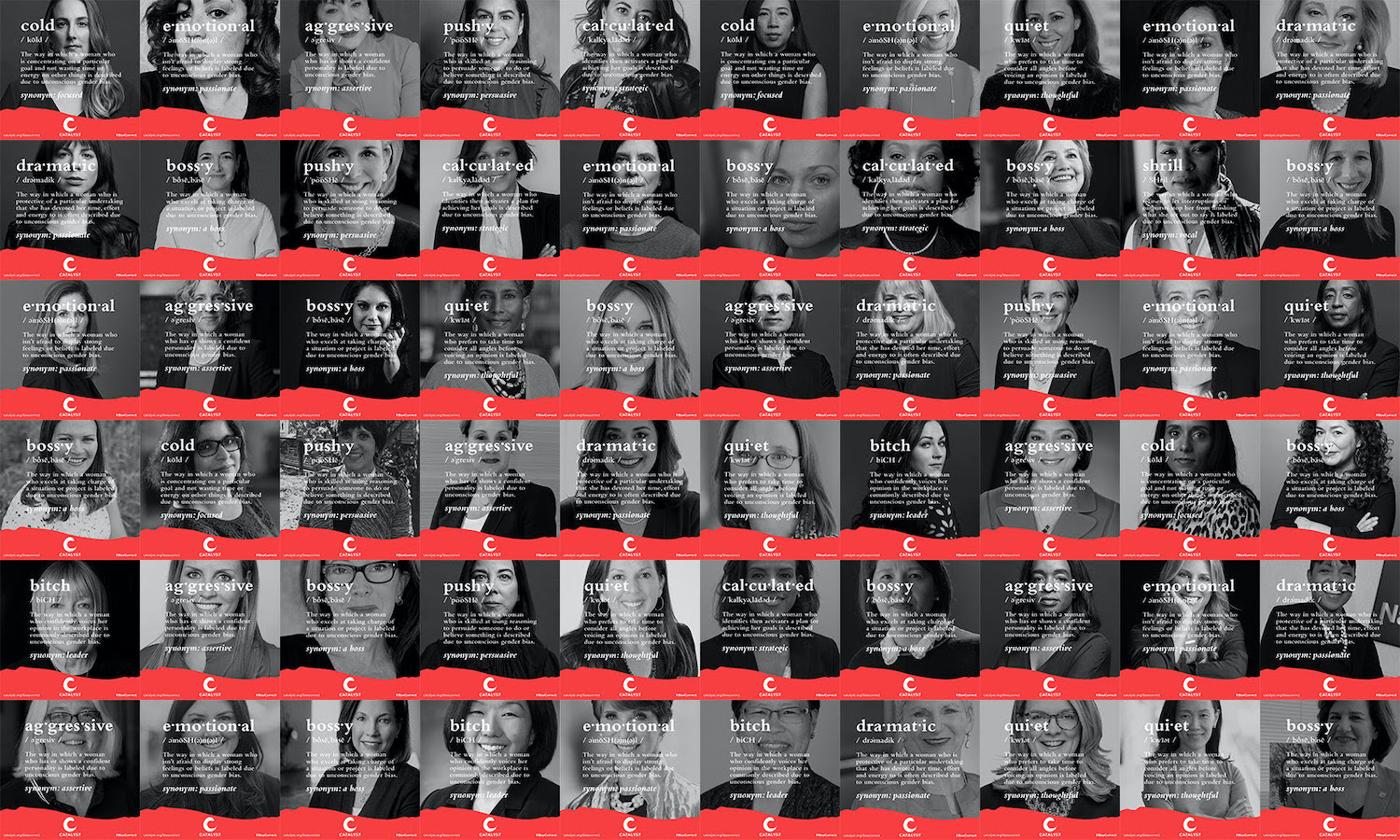
Naming, unpacking and dismantling gender bias in the workplace
The campaign is the latest iteration of Catalyst's #BiasCorrect series, which has run annually around International Women's Day since 2019.
In its first year, #BiasCorrect took the form of a social media campaign featuring images of influential women emblazoned with biased terms once used to describe them at work. (Hariton of Catalyst, for example, was once described as "aggressive," while former Secretary of State Hillary Clinton was labeled "bossy.") Catalyst and Burns Group invited women on social media to share their own experiences with gender-biased language using a photo generator that placed their experiences alongside famous women.
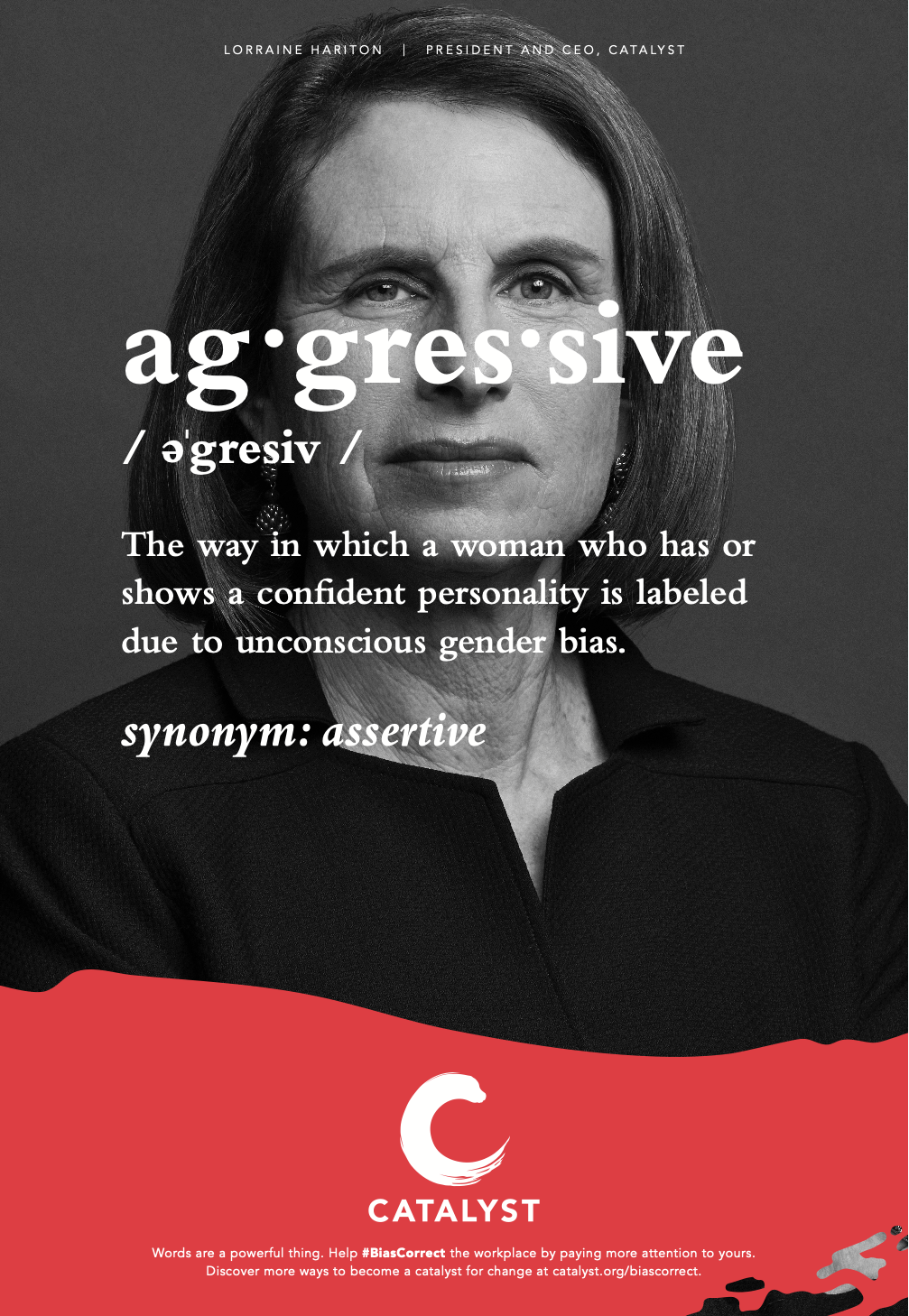
The 2019 campaign reached more than 188 million people across six continents, according to Catalyst estimates. It also included a plugin for the instant-messaging platform Slack, which spots bias in word choices and suggests alternative terms. Nearly 300 organizations downloaded the plugin in its first year, and it was open-sourced as part of the 2020 iteration of #BiasCorrect so it could be adapted for other messaging platforms.
Also in 2020, #BiasCorrect expanded its call-to-action to include men, who shared how they were described in the office using the same photo generator, making for some interesting side-by-side comparisons.
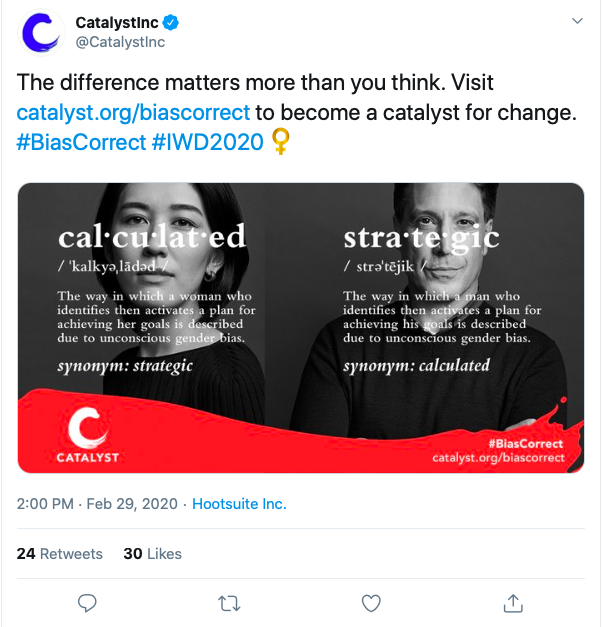
"We know the problem isn't fixed, and we're engaging men as gender partners ... to interrupt bias and help women advance," Hariton said last year.
Workers see opportunity for change
Catalyst's surveys document the prevalence of micro-aggressions and gender-biased language in corporate workplaces before and during the pandemic — particularly for women of color, who say they feel constantly "on guard" at work and hyper-aware of how they are perceived by their colleagues.
But the group's most recent polling indicates that workers are optimistic about the future. Around 75 percent of business leaders believe COVID-19 is an opportunity to directly address gender and racial disparities — and 7 in 10 employees believe workplaces will become more gender-inclusive in the wake of the pandemic.
If you'd like to be a part of the solution, Catalyst's #IWD2021 and #BiasCorrect pages include loads of resources to guide you along the way. And be sure to check out the group's Leading for Equity and Inclusion Workshops, a blended-learning curriculum designed to "empower leaders with the skills they need to build more inclusive workplaces."
Image credits: Brian Wangenheim/Unsplash and Catalyst
Closing the Gender Pay Gap with Climate-Style Data


The web of regulations covering corporate diversity disclosures in the U.S. allows for a yawning gender pay gap. This “ladies’ loophole” makes it difficult, if not impossible, for women’s equal pay advocates to make a data-backed case for reform. Nevertheless, hard evidence is beginning to emerge, and a new report on high-level pay disparity could help build momentum for the pay transparency movement.
Why measuring the gender pay gap is a daunting task
The new report covering the gender pay gap is from the firm Morningstar (the full report is available here).
The authors note that some gender-based reporting is required of U.S. corporations, but little is required to be made public. In addition, the authors describe a data loophole that shrouds gender-linked pay in mystery.
U.S. corporations are required to track race, ethnicity, and gender. They are also required to track CEO and median worker pay. But neither one of these metrics link pay to gender.
A warning sign from above
The Morningstar report covers the rarified world of C-suite pay, where even lesser-paid executives are amply rewarded. Regardless of gender, the authors note a median pay of just over $2 million in 2019, with the average coming in at almost $3.5 million.
Nevertheless, if pay disparity persists among women who presumably have the legal, educational, and career resources to negotiate a satisfactory salary, it is safe to assume that women farther down the corporate ladder are faced with a similar, if not worse, level of disparity.
The Morningstar report draws on senior executive pay data from its Executive Insight database, as disclosed in corporate proxy materials. Those disclosures include the CEO, CFO, and three more of the highest-paid, named officers. It includes the five-year period from 2015 to 2019, covering 2,384 companies in the Russell 3000 index (the Russell Index represents about 98 percent of all U.S incorporated equity securities, as it tracks the 3,000 largest U.S.-traded stocks).
“Whether measured by median pay or average pay, female senior executives earn considerably less than their male counterparts,” the authors conclude. “In 2019, median female NEO pay was $1.76 million, or 84.6 percent that of median male NEO pay.”
Other important findings on the gender pay gap circle back to the raw numbers of representation. Pay disparity aside, the Morningstar report finds that women receive that critical first promotion later in their careers and tend to be tracked away from profit-loss positions. That pattern establishes a “leaky pipeline” that cuts women off from the highest paid positions.
As a result, in 2019 only 47 percent of companies had at least one woman among their highest-paid executives, and only 12 percent had more than one.
The status of “being the only woman in the room” can overlay pay disparity with added stress. The authors cite a 2020 McKinsey survey finding that women senior levels of leadership frequently feel pressure to show more evidence of their competence, and this pressure results in the high likelihood of deciding to downshift their careers.
Signs of momentum for change - or not
The authors note that a fraction of progress has occurred since 2015, when women were paid 81.5 percent of their male counterparts. That pace of change is far from satisfactory, but they also note that pressure for accelerating reform is growing, even in the absence of new federal regulations to close the data gap.
“Litigation risk based on gender pay discrimination creates a source of financial exposure for corporations,” they write, citing the cases of Oracle and Google, which are the target of gender-based class action lawsuits.
The activist shareholder movement also appears to be stirring the pot. In the case of Oracle, the authors noted that 80 percent of outside minority shareholders supported a resolution on gender and racial pay reporting at the company’s November 2020 shareholder meeting.
Even as signs of progress in closing the gender pay gap are growing, the authors note a countertrend spurred by the COVID-19 crisis. As described in McKinsey’s 2020 Women in the Workplace report, almost 25 percent of women surveyed felt the effects of child care, elder care, and other new responsibilities leading to the possibility of cutting back on work – or even leaving the workforce entirely.
Taking a page from the climate action lesson
Aside from moral and ethical concerns, the authors point out that gender and racial pay disparity has negative consequences for the entire economy, and thus ripples back to impact individual corporations.
In that regard, the gender pay gap issue shares key similarities with the climate crisis, in which business-as-usual has created new, potentially existential risks to businesses across the board.
The climate crisis is also giving rise to new businesses and new opportunities, as a new low-carbon economy emerges. Gender and race equity have a similar potential.
The Science Based Targets initiative has garnered considerable support from hundreds of corporations that commit to goal-setting and transparency in reporting. In the absence of federal regulations, more corporate leaders could commit to a similar program of goal setting, road-mapping, and transparency for pay equity.
That still leaves the “leaky pipe” issue to resolve, but the bottom-line benefits of placing women in non-traditional roles is becoming more apparent. Insightful corporate leaders will gain an edge by ramping up their efforts to promote more women, more quickly, and by dedicating more attention and resources to outreach, recruitment and training.
Here’s one sign that a sharp acceleration in change is possible: In 2019, women at the U.S. Department of Energy developed a roadmap for resolving gender gaps through outreach efforts that recognize a range of difference in work/life balance for women. With newly appointed Energy Secretary Jennifer Granholm helming the agency as the first women in U.S. history to hold that position, it will be interesting to see what lessons can be learned in the years to come.
Image credit: Shutterstock
The Next Frontier for Boardroom Diversity: Private Companies


The glass ceiling hasn’t been completely shattered, but it is definitely splintering with more cracks. According to a recent Spencer Stuart Board Index report, every company on the S&P company index now has at least one woman on the board, and 47 percent of new directors appointed over the past year are women – the highest such year-over-year percentage increase. Credit goes all around for this boost in boardroom diversity: activist investors who have pressured companies, institutional investors who have made their case for having a more diverse board and the threat of mandates by state governments in California and Illinois. Companies can spin this trend all they want, but the trend is more out of self-interest than being a part of any “community.”
As many in business like to say, self-regulation is better than regulation coming from government. Nevertheless, this increased trend of boardroom diversity bodes well for professionals who have the skills, tenacity and chops, but not the connections in the good old boys network.
But for private companies, which do not have to face such pressure from regulatory agencies, investors or stock exchanges, we see a different narrative.
A new Crunchbase study suggests that while there has been improvement on boardroom diversity within privately-owned companies, such change can at best be described as mild “progress.” For private companies that have been founded since 2003 and have cumulative funding of at least $100 million as of last June, Crunchbase and its partner on this project, the social impact venture Him For Her, found 49 percent of the 350 companies they vetted lack any women on their boards.
That’s an improvement from the 60 percent reported during the previous year, yet there is still a long road ahead: The study concludes that at this rate, we won’t see women on later-stage private company boards until 2025, and anything nearing gender parity will be a decade away.
Plenty of evidence suggests that there’s a correlation between a company’s financial performance and it having some level of boardroom diversity. Beyond the bottom-line arguments, however, reality will dawn on many of these companies sooner than later. A good number of these companies are at the stage where they can mull becoming listed on public markets; and investment banks like Goldman Sachs have made it clear they won’t consider taking a company public unless their board shows some level of diversity. In that vein, Nasdaq has proposed similar requirements in order for companies to list on its exchange.
“These measures have the potential to push companies to diversify their boards earlier, instead of waiting until they face the scrutiny of public investors. But so far, these efforts are not enough,” wrote Emma Hinchliffe for Fortune earlier this week.
Image credit: Danielle Cerullo/Unsplash
A Wellness Products Company Built on the Heels of Personal Tragedy


A Canadian energy executive for most of his career, Bruce Mullen’s life took an unexpected detour into wellness products and become part of the natural and organic personal care industry - tipped to be worth $25 million by 2025 - when he founded the Vancouver, British Columbia-based Jusu Wellness and Jusu Juice Bars. While his business instincts were good, that new venture came on the heels of personal tragedy.
In 2011, Mullen’s wife, at age 48, was diagnosed with advanced breast cancer and died just 10 months later. While Mullen says he recognizes there’s no way of knowing why some people get cancer and others don’t, it took his wife’s death to get himself and his family to take a close look at their health and diet - a big wake-up call for his family, as he tells the story on Jusu’s website.
A rapid shift to wellness products
One thing, he said, became very clear: chemically processed food and beverages damages immune systems, and many common household cleaning products and beauty products are laden with chemicals - with very little regulation.
“We started going through our home, the pantry, the bathrooms, and noticed that everything we were eating, using to clean and putting on our bodies was just laden with chemicals that we couldn’t even pronounce,” Mullen told TriplePundit. “We decided to get rid of them and seek out products that are natural. My wife ultimately lost her battle with cancer, and on the one-year anniversary of her funeral, I myself was diagnosed with cancer. Eventually my son, who was studying business, approached me, telling me to get off the couch and together we founded Jusu.”
The aim of Jusu, which Mullen founded in 2014, is to provide 100 percent naturally sourced and plant-based household cleaning and beauty products for people “to protect themselves and their families by providing completely natural products for consumption, home and body,” explained Mullen.
Before founding Jusu, he spent his career with the Mullen Group, one of the largest transportation, logistics and energy serving businesses in Canada. These days, he says, he’s in the “human energy” business.
Ongoing debate over link between health and chemical-laden products
While the link between human health and household and beauty products containing chemicals is a subject of intense debate, Mullen says he believes that people underestimate the impact of chemicals on their health. “It has become so normalized to pick up a bottle of something to clean or eat or use on your body and ignore the mile-long list of ingredients on the back. I was once a part of this group and purchased these products without a second thought.”
While anecdotal, Mullen says several customers have said they experienced major health improvements after exchanging traditional products with his company’s wellness products.
Backing that view are groups such as EWG, a health advocacy group that has helped spearhead the clean beauty movement along with the Campaign for Safe Cosmetics. In written testimony to Congress in 2019, EWG’s Scott Faber said that 617 cosmetics makers have reported using 93 chemicals that have been linked to cancer, birth defects or reproductive harm in more than 81,000 products. He cited data from the California Safe Cosmetics Program, which is part of the state’s Department of Public Health.
Over years, researchers at academic institutions such as Harvard University, as well as the National Institutes of Health, have shared the connection of chemicals in personal and food products and risks to human health.
The demand for natural, “clean” or wellness products is part of the rise of the broader wellness movement. In other parts of the world, products come under far greater scrutiny. The European Union, for instance, has banned approximately 1,300 chemicals in cosmetics, a category that covers makeup, lotions, hair dyes, deodorant, nail polish, shaving cream and other beauty products, according to the Washington Post.
By contrast, the United States - where the average woman uses 12 such products containing 168 chemicals on her body each day - bans and restricts only 11.
Consumer demand for wellness products rising
Mullen predicts there will only be more companies producing wellness products like his: “I absolutely believe that the demand for natural products like ours is increasing. Before the pandemic hit, there was no big deal to go to the clinic, the doctor or the hospital, but people don’t want to go to the hospital now. People want to do whatever is necessary to protect their family.”
Indeed, global consulting and research firm Kline & Company has called the "natural" trend is the most important trend in the personal care industry.
“I am encouraged by the fact that we are seeing a lot of the major companies that use chemicals in their products are either changing their manufacturing practices or acquiring all-natural companies. There is a movement slowly happening,” Mullen says. “I think that this has also started to accelerate because of the COVID-19 pandemic. The pandemic is making people become increasingly aware of their immune health, and people are beginning to demand cleaner, healthier choices.
“People are realizing that we have the technology to develop product lines that are natural, without chemicals and actually add value to the product experience - we have moved far beyond just putting vinegar in a pail and spreading dirt around.”
Image credit: Viktor Forgacs/Unsplash
This Partnership is Out to Boost Career Prospects for Black Software Engineers
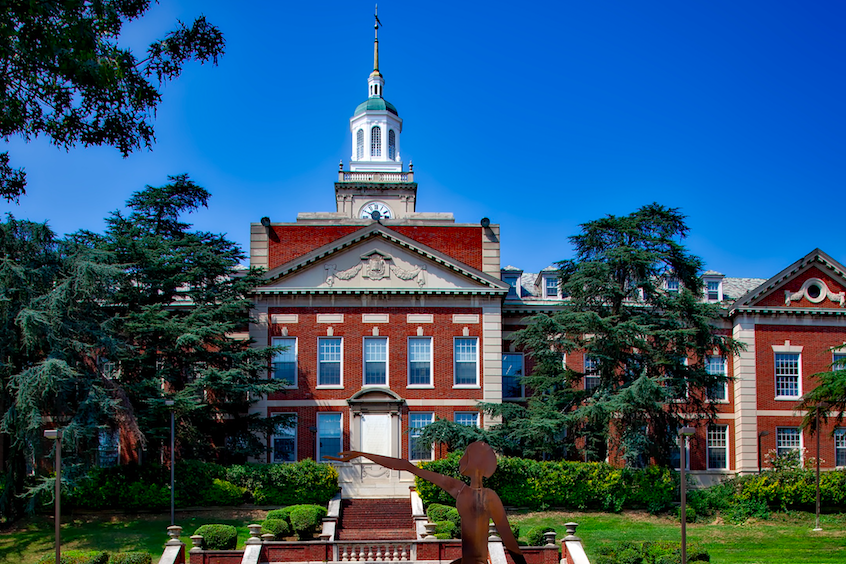
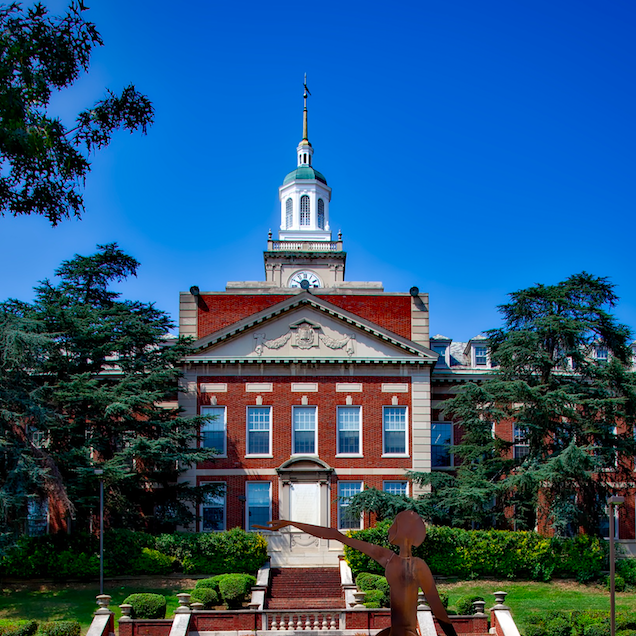
The process for landing a job as a software engineer, from the initial phone screening to receiving an offer letter, can be extensive, as one hiring manager has detailed. For Black software engineers, it is even more of a grind, given the barriers and attitudes that they often encounter within the wider technology sector.
As one engineer described in an Infoworld article last year:
“I would be the team lead, and my team and I would be holed up in a conference room at the client site. A member of the client executive team would walk into the conference room and assume that one of the white members of my team was the team lead. That team member would point to me and let that person know that the questions they were asking had to be answered by me.”
Here in the U.S., the tech sector is still overwhelmingly white, and yet many companies say they have a hard time finding talent — which, of course, raises questions about whether talent acquisition teams are getting it right in the first place.
To that end, Karat, which works with software engineering teams to take on challenges with the technical side of the job recruitment process, has launched a program it says can help expand access and fairness across the technology sector.
The program, called Brilliant Black Minds, started last year, and Karat says it’s formalizing that commitment with $1 million worth of practice interviews for Black software engineers.
Karat starts the process with enterprise-grade technical interviews for computer science students as well as professional developers. Following each interview session, the firm’s staff offers feedback and coaching to participants, noting how the potential interviewees perform well and where they could improve. Interviewees can also attend workshops with career engineers that run the gamut from interview preparation, how to best showcase their problem-solving skills in the interview, salary negotiation and networking tips so they bolster their long-term career prospects.
“Job candidates seldom get feedback from interviews, and it’s even less common for that information to make its way to the educators,” said Dr. Legand Burge, a Howard University computer science professor, in an emailed statement. “Karat’s ability to share the skills that hiring managers from top-tier tech companies are looking for, coach our students on how to crack the code of the technical interview, and guide our faculty on how to map our curriculum to meet those practical needs has been incredibly valuable.”
The program could certainly find traction at computer science programs such as the one at Washington, D.C.’s Howard University (pictured above), which by many accounts ranks in the top 10 percent of engineering schools across the U.S. According to Karat, more than 75 percent of of the university’s senior, junior and sophomore computer science students have participated in this program class last fall; Karat says more partnerships are in the pipeline to work with more Black software engineers.
Actions such as those taken by Karat and its partners are among the tools that can help build more promising job prospects for Black software engineers. The larger challenge, however, is the fact that many barriers that professionals face are systematic. As one software development school has pointed out, Black representation in the software sector has only increased one or two percentage points in the past 15 years; and various studies have suggested Black software engineers on average make $10,000 a year less than their white counterparts.
Image credit: David Mark/Pixabay
Mexico and Texas: Connected by Water, Agriculture, Energy, Immigration and Climate Change


Photo: Farms in Guanajuato, central Mexico, where the intersection of climate change, water scarcity and more demand for agricultural products are subjecting the region to more long-term risks.
Mexico is among the largest and most important trading partners of the U.S. In September 2020, total U.S. import-export trade with Mexico topped both China and Canada. That does not even come close to accounting for the ebb and flow of labor, across the U.S., and especially in states like Texas, which shares almost 2,000 miles of border with Mexico.
But Texas doesn’t only share geographic proximity and economic factors with Mexico. Both also face water, agriculture and energy challenges, especially in the face of a changing climate. Recently Mexico and Texas also shared in the power outages caused by the winter storm. In fact, one reason for Mexico’s blackouts were because of delayed natural gas shipments from Texas. And all of those factors are tied to Mexican immigration to Texas and beyond, which will only be exacerbated by climate change.
Agriculture, central to the looming battle over water
Water has long been an issue between Mexico and Texas, made worse by the frequent droughts and flooding on both sides of the border. In addition to water for consumption and industrial needs, water for agriculture is a critical problem across the board: no more so than in San Miguel de Allende, a historic town about 150 miles north of Mexico City in the state of Guanajuato, and home to over a thousand U.S. expats. This state in central Mexico is also a center for agricultural production and is at the crossroads of an ongoing battle over water.

Mexico is the U.S. largest agricultural trade partner in combined imports and exports, accounting for about 20 percent of U.S. agricultural imports. Of that, about two-thirds of U.S. imports from Mexico are fruits, vegetables and beer; hence climate change looms heavy over the food, beverage and agriculture sectors.
While employment nationally in the agricultural sector is around 11.5 percent, agriculture is an important part of the culture and identity of Guanajuato in addition to the economy. The area is semi-arid, but the region grows several water-intensive crops, such as broccoli, alfalfa and lettuce. And these farms continue to tap the region’s water, leading to not only concerns with quantity, but also quality.
In central Mexico, water supplies increasingly are unsafe
TriplePundit recently interviewed Dylan Terrell, Executive Director of Caminos de Aguas, a nonprofit working on open-source solutions for water-stressed areas in central Mexico. Terrell noted that about 85 percent of water extracted from the Alto Río Laja Aquifer, which serves several thousand communities including San Miguel, goes to agricultural products for export. “We’re over-extracting our water substantially,” he said. “Unfortunately, we’re also now pulling up ancient fossil water since we have to go so far down, and it’s mingling with fresh water, leading to high levels of arsenic and fluoride in the water.”
According to Tetra Tech, an engineering firm working in the region, more than 80 percent of the region’s communities have levels of arsenic that exceed the World Health Organization’s recommended limits by nine times and fluoride levels by 15 times. More research research indicates that the levels continue to increase. The severest impacts are on children, who are huge risk of dental and skeletal fluorosis, as well as cognitive problems. Neither a standard household filter nor boiling will eradicate the minerals. The solution requires specialized treatments such as reverse osmosis or chemicals.
Further, because of the growing demands for water and the importance of agriculture to the state's economy, priority is given to the industry rather than the supporting communities. According to Terrell, during the 1980s, once it became known that water was being extracted at unsustainable levels, the federal government prohibited new wells being drilled without approval. Yet despite that legislation, the number of wells in the watershed still grew from about 1,500 in the early 1980s to approximately 3,500 now, with many drillers claiming grandfathered drilling rights. And with climate change likely leading to more water quantity uncertainty, addressing that problem increasingly becomes paramount.
The challenge: finding solutions for overconsumption of water
Caminos de Aguas has been teaming up with organizations such as Engineers Without Borders UK, the work of which was in part funded by a grant from Tetra Tech, to secure supplies of safe drinking water for residents in San Miguel de Allende. The organization has also worked with academic institutions in Mexico and the U.S. to help address the water problems in the communities throughout the wider region. Beginning in 2012, in partnership with four universities, researchers mapped the area’s water quality, overlaying it with state water data, and began offering free water testing for communities as well as water quality monitoring.
Pinpointing water pain points has enabled targeted solutions like rainwater harvesting at the community, school, and household level during rainy season. But rainwater harvesting is a tool in the arsenal rather than a long-term solution, especially with the predicted long-term decreased rainfall due to climate change. In order to solve the problem, the root cause of over-exploitation must be addressed, which will require difficult conversations with Mexico’s federal government and the agricultural sector.
The German Agency for International Cooperation (GIZ) - which has a mission similar to the U.S. Agency for International Development (USAID) but with more of a business focus - has begun working in the region. The organization is especially focused on engaging the tourism sector to invest in climate change solutions linked to watershed rehabilitation.
A documentary about groundwater exploitation in Guanajuato, in Spanish with English subtitles.
Terrell explained that while the solutions involve all relevant stakeholders, “the priority should be on the sustainability of the watershed and the communities it serves.” As countries across the globe tackle difficult, entrenched climate-related problems, the economic interests must not be prioritized at the expense of the preservation of the resources and the communities that rely on them. Without the balance of sustainability, health, and economy, no one wins.
Image credit: Ramy Loaiza/Unsplash
What Business Can Learn about Gender Diversity from the U.S. Department of Energy

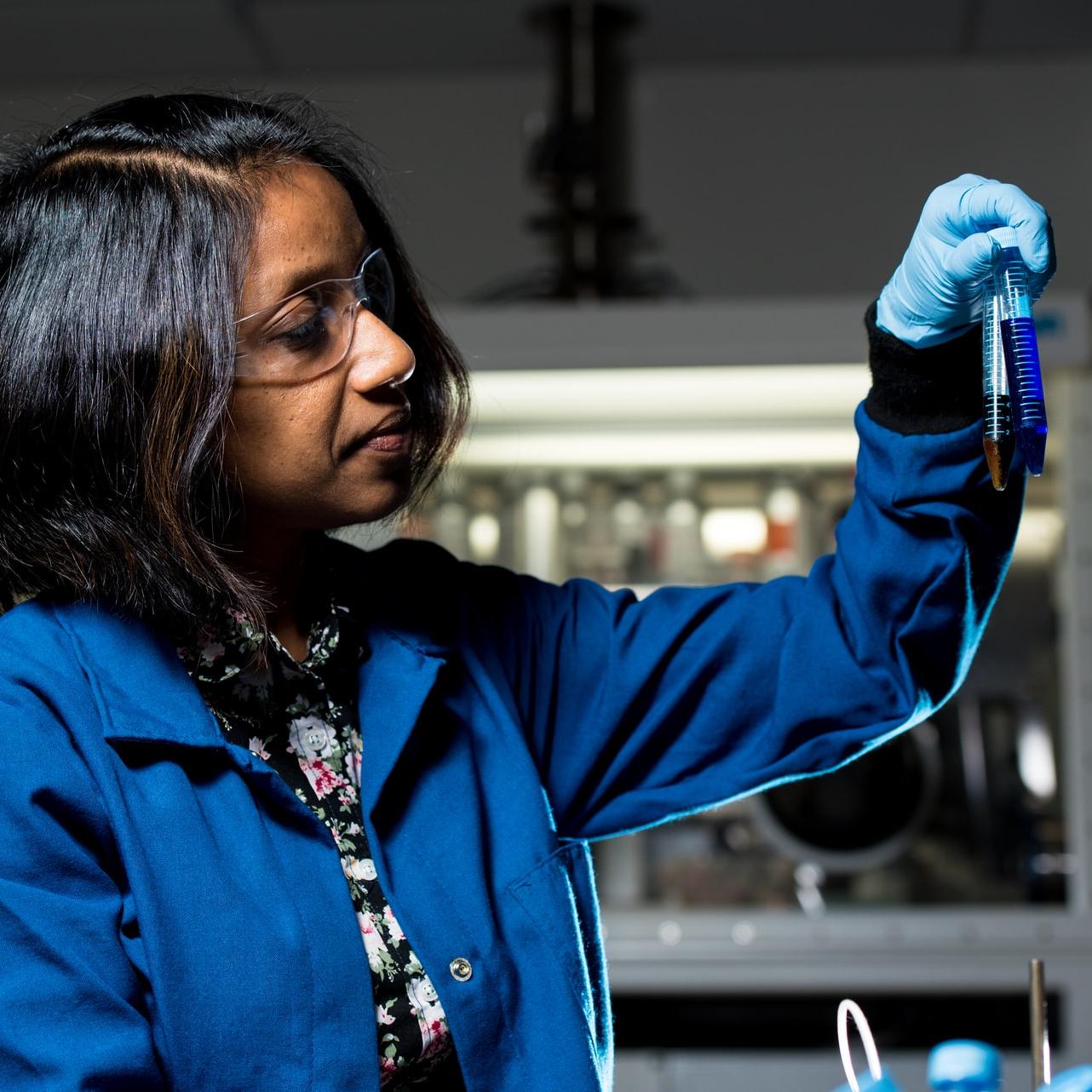
It is difficult to overstate the significance of Jennifer Granholm and the ways in which she has led, among them furthering gender diversity. As the first woman to serve as Energy Secretary for the U.S., Secretary Granholm will steer policy for a nation that leads the world in energy production as well as scientific research, through a network of 17 national laboratories and hundreds of partners.
The Department of Energy (DOE) also oversees the nation’s nuclear stockpile and is intimately entwined with national defense goals. Granholm’s leadership can make or break the U.S. as a superpower that holds the key to averting catastrophic climate change - and for the first time, many women seeking careers in energy will see a role model in the driver’s seat.
The significance of the U.S. Department of Energy
Granholm is best known for her efforts on behalf of electric vehicles and other issues related to the clean energy transition as the former Governor of Michigan from 2003 to 2011.
The transitional aspect of her approach is the key. As Michigan’s governor, she recognized that Rust Belt states like Michigan had fallen behind in a period of great global transition, and she looked to the future for trends that could uplift the state’s economy.
In that regard, Granholm dovetails perfectly with President Joe Biden’s focus on climate action. However, it is important to recognize that the mission of the Department of Energy sprawls far beyond global decarbonization and the clean energy transition.
As articulated by the Obama administration, the department’s involvement with the Department of Defense is a central part of its mission, such as in the area of nuclear-powered submarines for the U.S. Navy. DOE “contributes fundamental scientific discoveries and technological solutions that support the nation’s primacy in science and innovation,” and that includes “accelerating and expanding efforts to reduce the global threat posed by nuclear weapons, nuclear proliferation and unsecured or excess nuclear materials.”
“As a result of the expertise developed to support these nuclear security missions, DOE laboratories also serve as strategic assets in support of broader national security missions,” the Obama administration noted.
The DOE is also tasked with leading “the largest cleanup effort in the world to remediate the environmental legacy of over six decades of nuclear weapons and nuclear research, development, and production,” with health and safety implications for staff as well as within local communities.
Women at the U.S. Department of Energy
DOE is a relatively young agency, having been formed by an act of Congress in 1977. The intent was to gather several defense responsibilities under one umbrella with a scattering of other federal energy-related programs.
Women have been instrumental within that history, considering that the agency’s defense work is rooted in the World War II nuclear weapons Manhattan Project, an achievement built on the work of the women scientists Marie Curie and Lisa Meitner, among many others.
Women scientists have continued to play leading roles in U.S. energy research and innovation through the years. Nevertheless, the legacy of gender diversity in the Manhattan Project did not carry forth to the next generation.
In 2019 Mary L. Hoover, Manager of the Laboratory Leadership Team at Sandia National Laboratories, took stock of gender diversity among the 17 national laboratories in a report titled, “Illuminating the Role of Women at the Department of Energy National Laboratories.” Compared to 50 percent female representation in the overall U.S. workforce, Hoover notes that representation at DOE only hit the 30 percent mark. The breakdown for technical and research positions is even more concerning.
“Women make up only about 18 percent of these ranks in contrast to the percentages of women in computer science (25 percent) and physical science (39 percent) in the U.S. workforce,” Hoover writes.
“These current statistics are not the desired state for the DOE National Labs and contrast sharply with the long history of accomplishments by women at the Labs. We believe the DOE National Labs should lead the charge on diversity and inclusion (D&I) and serve as a model enterprise for bringing women into our scientific and technical workforce,” she adds.
Is work/life balance overrated?
Hoover’s recommendations helped provide a roadmap for Secretary Granholm to recruit more women, and in many respects, they also apply to the private sector.
As noted by Hoover, the DOE has made some efforts to highlight the contributions of women throughout its history. However, based on her experience and that of her peers, Hoover recommends a more inclusive approach that acknowledges the different types of women who would be attracted to a career in the national laboratory network.
“We believe there is an opportunity for more sharply targeted recruiting so that we can attract a new generation of females to join the National Labs, retain the current workforce, and improve the representation of women at the Labs,” she writes.
“We identified that despite a popular belief that women interested in DOE National Labs careers are seeking work/life balance, our own motivations have been driven largely by the opportunity to work with outstanding people and contribute to important and big challenges - as only the DOE National Labs can offer,” she explains, adding that “We believe that highlighting the opportunity for women to perform impactful work and team with extraordinary people would be a compelling message to relay for attraction and retention purposes, in addition to sharing the message of work/life balance.”
A message for businesses seeking gender diversity
Hoover’s message is clear: different women have different home lives and expect different things from their work. As a matter of recruiting top talent, lumping all women into the work/life balance pool neglects to address the abilities and aspirations of those with the drive and energy to tip the scales in favor of work.
In other words, gender diversity should not be a catch-all for one kind of woman. Businesses seeking top talent need to address the full range of lifestyle, from women who center themselves around their personal and family lives to those for whom more fulfilling hours take place on the clock.
In the months and years to come, Secretary Granholm may provide some key guidance in that direction.
It is to be expected that Granholm will continue DOE’s ongoing efforts to recruit more women in STEM. She will demonstrate a real difference in leadership, though, by stepping up those efforts to lead the Energy Department in a gender diversity transition that focuses more resources on highlighting women’s achievements at DOE, and developing new recruitment strategies and networks that attract and retain women across the full range of work and life.
Image credit: Science in HD/Unsplash
Choose to Challenge? Women Over 50 Invented It.
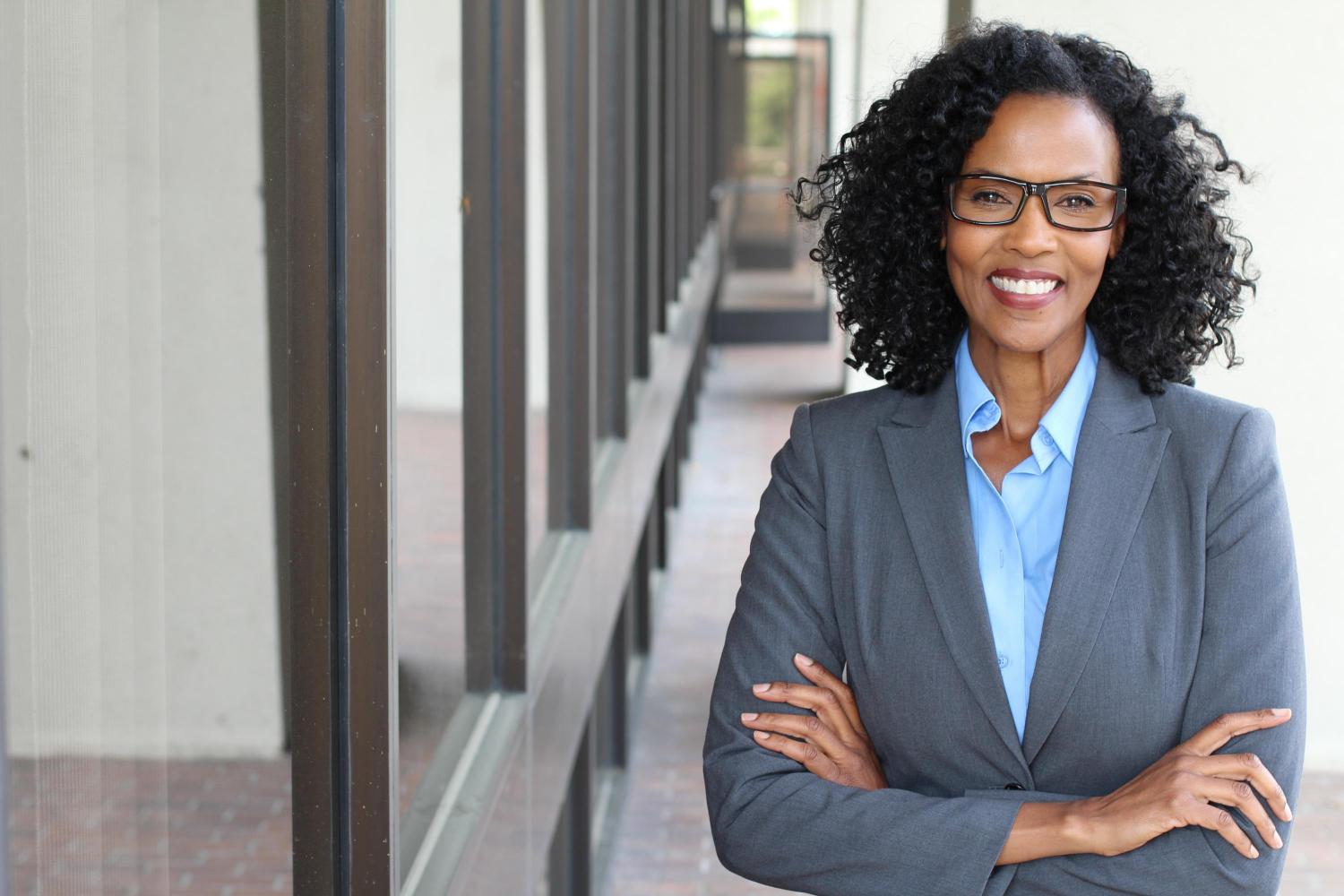

With International Women’s Day 2021 coming up on Monday, this year’s theme, “choose to challenge,” is timely, considering how women have largely shouldered the burdens that the global pandemic has piled on over the past year. Yet if we’re talking about choose to challenge in a wider context, face it: Women over 50 years old wrote the playbook.
Let’s start with what many women over 50 have lived through both in their personal lives and professional careers. For those born around 1960, here’s only the start: We’ll begin with the “stagflation” of the 1970s, the recession of the early 1980s, the early 1990s recession, the post-9/11 shock, the financial crises of 2008-2009 and, of course, the chaos this pandemic has fomented. That resilience helps explain why one recent report suggested that many women over 50 have few, if any, qualms about starting their own businesses.
Many women over 50 have also lived their lives during the “no women’s land” era of the fight for full gender equality. That is, they are too young to remember when women’s options were limited to only a few careers and later, when — gasp! — the Mary Tyler Moore Show broke new ground by focusing on a 30-something single woman with a career and who was fine with it. Yet they do remember a time when only two women were in the U.S. Senate and very few women were in the C-suite, let alone served as a CEO. Many were also of a working age when Anita Hill’s allegations sparked days of live television news coverage, which largely portrayed her as more of a villain than a truth-teller. Their education and early career years came at a time when there was no talk about STEM, diversity or much discussion about “knowing your value.”
Their reality, and their years of experience, steeled these women to become the force they are today. While our youth-obsessed culture tends to focus on millennials and Gen Xers who many have lauded for their trailblazing, doing-it-differently ways, the fact is that women over 50 built those same roads currently enjoyed by younger generations.
“The women I know aren’t declining. They’re getting stronger and more engaged in careers, often second careers they love. They are starting businesses. Some are taking greater risks, often to make a greater impact,” Elizabeth MacBride wrote for Forbes two years ago.
The statistics back up MacBride’s claims. True, overall the pandemic has not been kind to women in their 50s. But over the past several years, the number of entrepreneurs in the U.S. who are over 50 years old keeps increasing, and their share currently stands at a steady one out of four. Assuming mass vaccination and herd immunity brings a renewed sense of normalcy, there’s no reason to think such trends cannot continue.
Now, these women are getting their due. Forbes, for example, will announce its “50 Over 50” this summer, and we can expect women who have earned their seat at the C-suite “boys club” will be among those on the list. Meanwhile, MSNBC’s Mika Brzezinski has launched a “Know Your Value” series that showcases the accomplishments of women over 50.
But for many of these woman, they’ve known their value all along, and are still choosing to cash in on it. And they can cash in because they are strong in ways others fall short: experience and perspective.
Image credit: Shutterstock